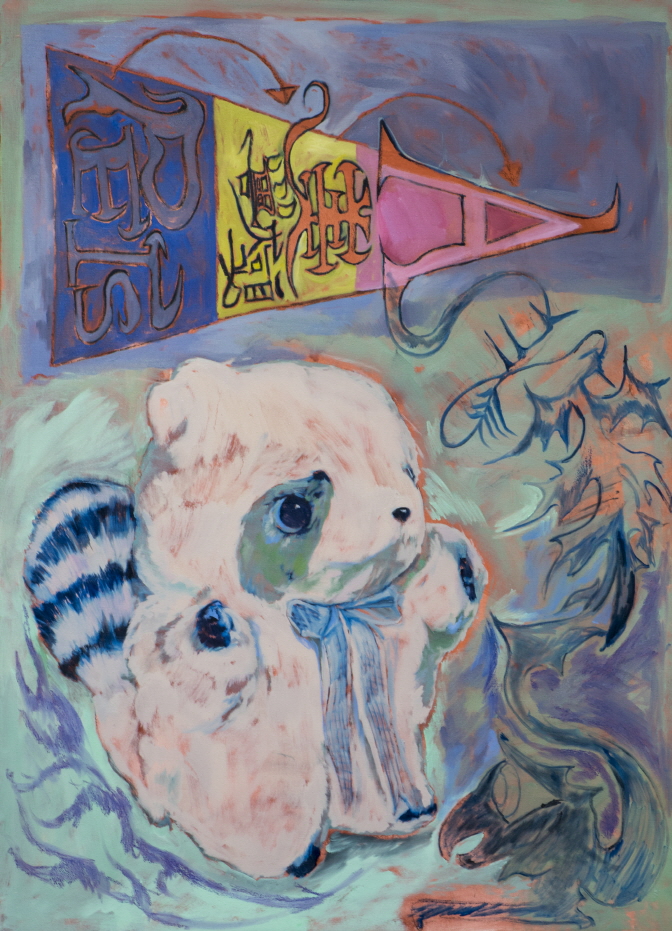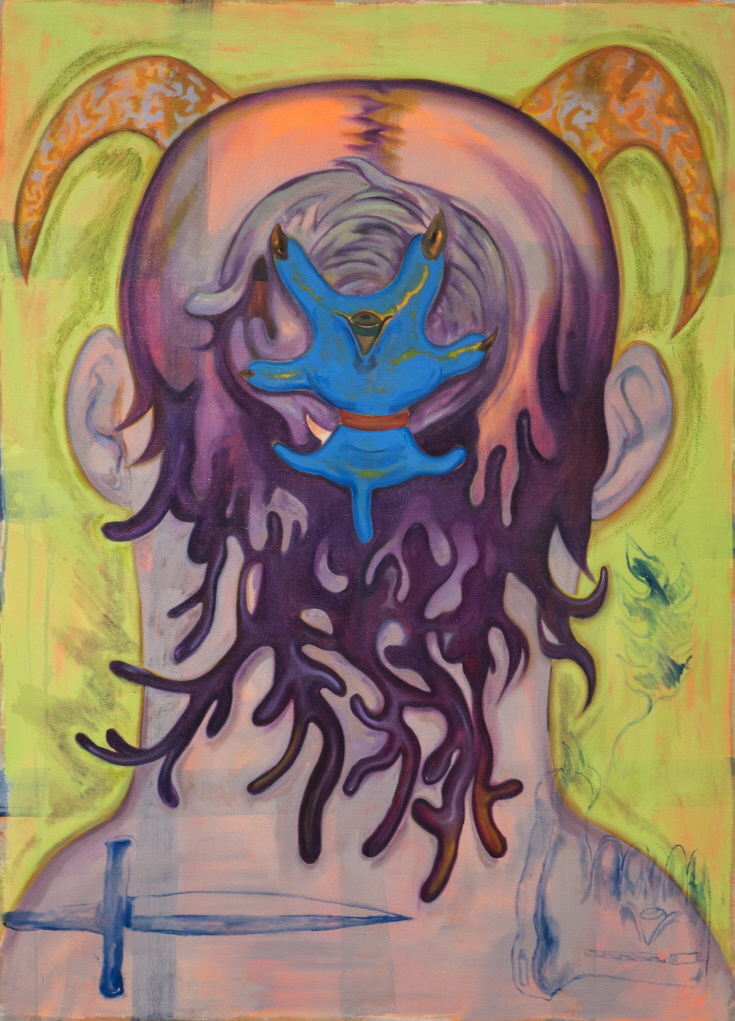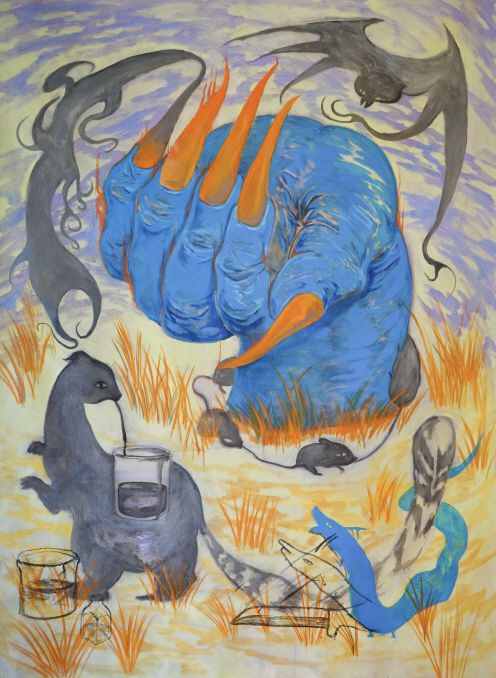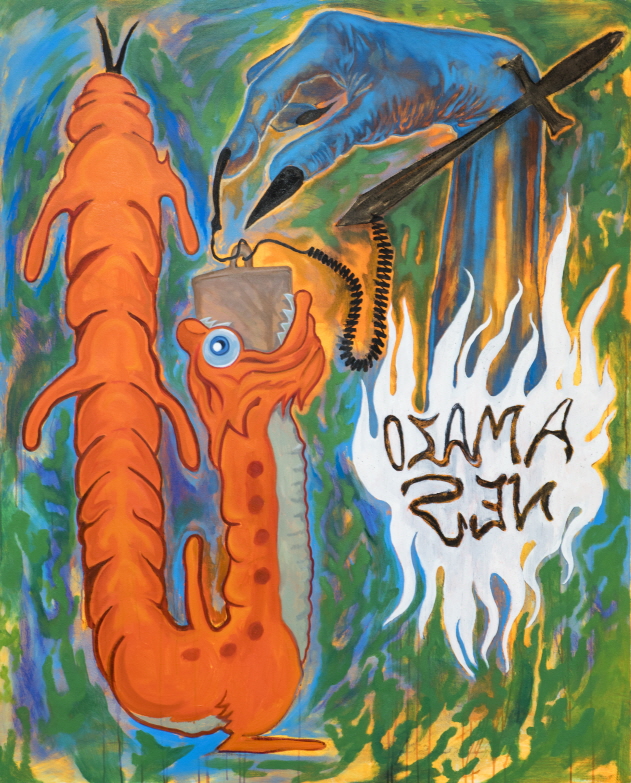Education
2019 MFA Kyoto city university of arts (KCUA), Painting Department, Kyoto, Japan
2016 BFA Tōhoku University of Art & Design (TUAD), Fine arts Department, Yamagata, Japan
Solo Exhibition
2024 “Treed Codependency”, GalleryMEME, Seoul
2023 "Looming digits" Blue velvet, Zürich
2023 "The Elastic Edges" Ritsuki Fujisaki, Tokyo
2022 "The Monopolistic Sweet Spots" MAMOTH, London
2022 “Tools are validated” Tang Contemporary Art, Bangkok
2022 "黩 Blacken” HIVE CENTER FOR CONTEMPORARY ART, Beijing
2022 "被制限的行動、心理電影" HUA ART SPACE, Beijing
2021 "現れるのに勝手はない/ No excuses for showing up" LEESAYA, Tokyo
2021 "Hierarchy of Beasts" GalleryMEME, Seoul,
2020 "In search of..."14a, Hamburg,Germany
2019"たりない循獣 / Unsatidfied animals of the cycle" , GINZA TSUTAYA, Tokyo
2019 "IDÉE FIXE, Tong Gallery + Project, Beijing
2018 "Tiger Poet", CLEAR GALLERY, Tokyo
2017 "THE WOMEN FROM THE GROUND,DNA", N’s art project, Osaka,
2017 "Jungle -7,000,000", MORI YU GALLERY, Kyoto
2017 "Tiger Technique", KCUA, Kyoto
Selected Group Exhibition
2023 "Fungal Fugue", HAGIWARA PROJECTS, Tokyo
2023 "CARE PACKAGE", Blue Velvet Project, Zürich
2022 "The Tale of Tales", G Museum 金鹰美术馆, Nanjing
2022 "Cope", No Gallery, New York, curated by Sven Loven
2022 "Temple", Seventh Gallery, Melbourne, curated by Michael Kennedy
2021 "Couple of", Hive contemporary art center, Beijing
2021 "Slow Culture" ,@KCUA, Kyoto
2021 "Low Fever", Tang Contemporary Art, Hong Kong
2020 "COLLECTION AS POEM IN THE AGE OF EPHEMERALITY" , X museum, Beijing
2020 "Y -generation artists" GINZA TSUTAYA ATRIUM, Tokyo
2020 "A Delinquent Child Having An Out Of Body Experience" THE RESIDENCE GALLERY, London
2019 "Complete Metamorphosis" SuperDutches, NewYork, U.S
2019 "Scaffolds of Meaning / 懶音", MINE PROJECT, Hong Kong
2019 "Feelings for a spider" 4646, Tokyo, Japan
2019 "Amazondom" Pulp,Osaka,Japan
2019 "KUMA EXHIBITION 2019", Spiral, Tokyo, Japan
2018 "Encounters", PDX CONTEMPORARY ARTS, Portland, Oregon, US
2018 "KUMA EXHIBITION", Spiral, Tokyo, Japan
2018 "KAISEI", Pehu,Osaka,Japan, Galerie P38,Paris,Frense, KG,Tokyo,Japan
2017 "The 4th CAF prize exhibition" Hillside terrace, Tokyo,Japan
Public collection
Star Museum (Shanghai), He art museum (Guangdong), X museum (Beijing), Tōhoku University of Art & Design (Yamagata)
Artist program
2017 "Feldstärke International", Hunan University,China, Daegu Art Factory,S.Korea, Kyoto Art Center,Japan
2016 "End of summer", Yale union Contemporary art center, Portland, US
Others
2022 Art News Japan 30 artists nominated
2021 "30 artist Under 35" by ARTnews Japan nominated
2021 KUMA Foundation grant recipient
2020 The Peter S. Reed Foundation grant recipient
2018 ARTIST’S FAIR KYOTO, Kyoto, Japan
2018 KUMA Foundation scholarship student
전시서문
Hierachy of Beasts, 카이토 이츠키 개인전, 2021. 6. 23 ~ 8. 15
수치심의 신화
그것은 ‘선언’ 같았다. 하네스, 쇠고랑, 벨트에 결박된 벌거벗은 사내의 모습이 불균형 상태로 고착되어 온 어떤 힘의 위계를 흔들어보겠다는 강력한 기호로 읽혀졌다. 그래서 작가와의 서면 인터뷰는 젠더 간의 통상적인 억압주체와 객체의 위치를 전복시키는 것인가, 라는 질문으로 시작됐다. 영국과 독일·미국·중국 등지에서 활발히 활동을 이어오고 있는 카이토 이츠키(皆藤 齋, Kaito Itsuki) 작가의 대답은 예상을 비껴갔다.
“주로 아시아권 전시 때 많이 받는 질문이다. 그보다는 신체 밖으로부터 오는 사회적 역할의 다양한 요소를 담아내려고 한다.”
여성에게 더 엄격한 예의범절이 요구되는 일본사회에서 카이토 이츠키 작가의 작품은 예의 바르지 않다. 비도덕적이고 폭력적이며 때로는 불쾌하기까지 한 도상들이 단골로 등장한다. 그런 그를 Forbes JAPAN은 지난 2018년, 차세대를 이끌어갈 30세 미만의 혁신가(‘NEXT UNDER 30’)로 선정하면서 ‘그림을 그리는 건 싸움이었다’라는 제목의 인터뷰로 소개했다. 마음 밑바닥의 뒤틀림, 결핍, 고통에 가까운 욕망 등을 정신적 비료 삼아 자신의 이야기를 단단하게 직조해 나가는 강렬한 영아티스트의 모습이었다.
그리고 2021년 2월, 일본 미술전문지 미술수첩(美術手帖, Bijutsutecho)은 도발적 취향의 이 작가를 일본작가 100인에 선정했다. 모리미술관 학예사는 ‘신화나 우화를 원형으로 한 추악하고 난해한 행위들 속에서 작가는 자아에 대한 이해를 시도해 왔다.
이 디지털 시대에, 유화로 그려진 인간상에 작가 자신과 우리의 모습이 비추어지고 있는지도 모른다’고 평했다.
세상의 이런 관심은 어떤 점이 매혹의 장치로 작동하는가에 대한 호기심을 불러온다. 칼과 낫, 선정적이면서 섬뜩한 손톱, 얼굴 없는 나신의 남성이 주요 소재다. 이와 함께 기괴한 모습의 개와 야생성을 잃은 호랑이, 서늘한 기운의 봉제인형 등 익숙함을 기이함으로 변형시킨 동물 이미지들이 등장한다. 이들의 생경스러운 조합은 밀실의 의식과도 같은 시나리오와 결합되면서 안티모럴과 수치심, 나르시시즘 등이 한데 뒤엉킨 초현실적 풍경이 된다. 신비와 혼돈의 풍경을 따라가다 보면 문득 자아의 괴물성을 자각하는 것과 같은 낯설고 불편한 경험과 마주하게 되기도 한다.
이에 대해 작가는 “현대인의 사회생활에서는 결코 보여질 수 없는 언더그라운드 콘텐츠에서 많은 영향을 받았다. 그러나 작품에 등장하는 성적, 비도덕적 이미지들은 타인과의 상호작용에 의한 것이 아니다. 그것들은 나의 내면을 향한 나선형의 방향으로만 존재한다. 폭력성도, 부도덕함도, 쾌감의 순간과 수치심 모두 나를 향하고 있다”고 설명한다. 그러면서 “타자나 사회로부터 이해될 수 없는 행위, 생산성 없는 낭비 따위로 치부될 수도 있지만 누군가에게는 인간으로 존재하기 위한 절실함의 은유일 수 있다. 예술이라는 행위도 그와 다르지 않다고 생각한다. 나만의 신화를 찾아가는 과정이기도 하다.”고 덧붙인다.
소설 ‘산월기’(山月記, 나카지마 아쓰시 中島 敦)를 모티브로 한 최근의 연작들은 자기애를 향해 더욱 치밀해진 작가의 사유를 보여준다. 일본의 교과서에 실릴 정도로 널리 알려진 이 소설에 등장하는 호랑이는 비겁한 자존심과 거만한 수치심(cowardly pride and arrogant shame)의 상징이다. 바람직한 인간성을 해치는 것으로 간주되는 이런 결함은, 그러나 작가에게는 사회와 타자로부터 부여받은 역할을 거부하는 능동적 태도로 받아들여진다. 작가는 이 지점에서 자신의 미의식의 뿌리가 결함을 끌어안는 자기애 곧 나르시시즘이라고 설명한다. 현실의 세계와 내가 부딪히는 지점에서 세상으로부터 부정적 요소로 간주되는 취약성을 기꺼이 선택한다는 것이다.
그런 이유에서 특정 젠더와 성적 폭력의 이미지가 반복적으로 다뤄지고 있음에도 억압과 불평등에 대한 분노나 연대를 향한 외침의 온도는 느껴지지 않는다. 수치심의 도상들에도 비루함이 없다. 도리어 멀쩡한 속내를 짐짓 어눌한 듯한 모습으로 가장하는 우화의 천연덕스러움이 묻어난다. 그리고 도저히 어울릴 수 없는 소재들 사이에서 파생되는 불협화음이 리드미컬한 역동성으로 작용하며 화려한 쾌감을 향해 치닫는 듯 보인다. 실제로 작가는 자신과 작품에 대해 매우 긍정적이고 쾌활하다고 자평한다. 이는 현실에서 이상을 보는 낭만성과 맞닿아 있다. 수치심과 상처의 영토에서 낭만적 자기인식을 키워나가는 방식으로 보인다.
갤러리밈 기획으로 한국에서 처음 선보이는 카이토 이츠키 작가의 작품세계는 아름답지 않다. 보편적이지도 않다. ‘야수들의 계급’ (三獣のヒエラルキー, Hierarchy of Beasts)이라는 전시 주제처럼 작가는 자신의 신화 속에 등장하는 존재들을 관찰자의 시선으로 바라보면서 독특한 내러티브를 이어 나간다. 이야기의 시작은 신화라면 으레 등장하는 초월적 영웅의 존재를 들어내고 그 자리에 수치스러움과 두려움 따위를 채워 넣는 작업이었다. 내면의 바닥을 똑바로 바라보는 용기가 전제되지 않고서는 가능하지 않은 일일 터이다.
신화란 실제로 존재하지 않기에 신비와 영원성이 가능하다. 그리고 예술가란 세상이 이해하지 못하는 어떤 것들과 싸워야 하는 존재다. 이 두가지 조합이 작가로 하여금 자신만의 신화를 엮어내게 하고 세상의 정형성으로부터 걸어나오게 했을 것이다. 문명과 야만의 구분이 시시해지고, 남성과 여성의 위치가 전복되고, 인간과 동물의 위계가 뒤섞이고, 자유와 구속의 정의가 모호해지고, 그러면서 혼돈과 질서가 사이좋게 중재되는, 이방의 이 젊은 작가가 만들어낸 신화의 풍경 앞에서 잠시 멈춰서보길 권한다. 세상 모든 가치의 잣대들로부터 한 발 물러서서 마음 속 검은 우물을 들여다보기 딱 좋은 순간이다.
갤러리밈 전시기획자 김현진
The Myth of Shame
It was like a ‘declaration’. The figure of a naked man tied to a harness, handcuffs, and belt was read as a strong sign of shaking the hierarchy of a certain power that had been fixed in an unequal state. So, my written interview with the artist started with the question, “Are you overturning the typical positioning of agent and object in the gender dynamic?” The answer from Itsuki Kaito(皆藤 齋), who has been active in the UK, Germany, the United States and China, was unexpected. “That’s a question I get a lot when I hold exhibitions in Asia. Rather than that, I try to capture the various elements of social roles that are transmitted from external sources to the body.”
Itsuki Kaito's work does not follow the etiquette of Japanese society, where women are required to follow strict social rules. Images that are immoral, violent, and sometimes even offensive appear often. In 2018, Forbes JAPAN selected her as one of 'NEXT UNDER 30', a group of innovators under the age of 30 who will lead the next generation, featuring an interview with her entitled ‘The act of painting was a fight.’ It conveyed the image of a passionate young artist who firmly weaves her own story, using twists, deficiency and desire which is so deep it borders on pain as a prompt.
In February 2021, Japanese art magazine Bijutsutecho(美術手帖) selected this provocative artist as one of the top 100 Japanese artists. The curator of the Mori Art Museum said, “The artist has tried to understand the self amidst ugly and esoteric acts based on the archetypes of myths and fables. In this digital age, the images of the artist and of ourselves are probably reflected in the human figures painted in oil.”
The interest Kaito’s work has generated raises the question of which types of subjects arouse the curiosity of the audience. Kaito’s main subject matters are the sword and sickle, sensational and eerie fingernails, and the naked man without a face. Along with this, animal characters such as bizarre creatures from mythology, the tiger that has lost its animal instinct and rag dolls emitting creepy energy collide with each other noisily. Their strange combination is fused with the artist's proposed scenario, which is that of consciousness in a secret room creating a surreal landscape in which the immoral, the shameful and the narcissistic are entangled together. As you delve into this mysterious and bizarre landscape of chaos, you may encounter unfamiliar and uncomfortable experiences, such as being aware of the monstrosity of the self.
The artist explains, “I was greatly influenced by the underground contents which is not visible in contemporary social life. However, the sexual and immoral images that appear in my works are not drawn from interactions with others. These exist only in direction towards my inner self. Violence, immorality, moments of pleasure and shame are all directed at me.” She adds, “These things are regarded by others or by society as incomprehensible, as wasteful due to the lack of productivity, but for some, they can be metaphors for the desperate ctions we take to exist as human beings. I think the act of creating art is no different from that. It is also a process of finding my own myths.”
Kaito’s recent series, based on “The Moon Over the Mountain” by Atsushi Nakajima, conveys more elaborate thoughts regarding narcissism. The tiger in this novel, famous enough to appear in school textbooks of Japan, is a symbol of cowardly pride and arrogant shame. These defects, which are regarded as anathema to desirable human conduct are, however, accepted by the artist as an active attitude that rejects the roles imposed by society and other people. At this point, the artist explains that the root of her aesthetic consciousness is love for oneself, i.e., narcissism that embraces such flaws. At the juncture where the real world and the ego collide, she is willing to choose her vulnerabilities, which are considered negatively by the external world.
For this reason, even though images of certain genders and sexual violence are repeatedly addressed, there seems to be no anger over oppression and inequality, nor a call for solidarity. Even the images of shame bear no trace of criticism. Rather, they show the unaffectedness and feigned ignorance of the allegory, which pretends to be inarticulate. It seems that the dissonance generated between subject matters that are unmatchable with each other is a rhythmic dynamism, rushing towards splendid jouissance. In fact, the artist claims to be very positive and cheerful about herself and her work. This relates to the romanticism of seeing the ideal in reality. It seems to be a way to develop romantic self-awareness in the territory of shame and trauma.
Itsuki Kaito's art, which is first showcased in Korea by GalleryMEME, is not beautiful nor is it universal. As in the theme of the exhibition ‘Hierarchy of Beasts’ the artist creates a unique narrative by looking at the beings that appear in her myth through the eyes of an observer. The start of this interesting story was to remove the transcendental hero that usually appears in mythology and instead fill this place with shame and fear. This would not be possible without the courage to look straight at the dark elements of oneself.
Since myths do not really exist, mystery and immortality are possible and an artist is a being who has to fight something the world does not understand. The combination of these two would have allowed the artist to weave her own myth and step out of the stereotypes of the world. In the mythical landscape created by this young artist from a foreign country, the distinction between civilization and barbarism becomes insignificant, the positions of men and women are overthrown, the hierarchies of humans and animals are mixed and the definition of freedom and bondage becomes obscure and in the meantime, chaos and order are well mediated. I hope you will stop for a moment in front of this landscape. It is a perfect moment to take a step back from the values and standards of the world and look into the black well within us.
Hyunjin Kim Curator, GalleryMEME
Treed Codependency, 카이토 이츠키 개인전, 2024. 1. 17 ~ 3. 15
‘Treed Codependency’
This young artist’s territory has been expanded. The cacophony of the icons of shame, fake, displeasure, and hybrid, mixed with enigmatic metaphors, has become more intense as well. But such is the appeal of her works. The artist refers to her solo exhibitions in New York, London, Bangkok, Beijing, Hong Kong, and Zurich, following her last exhibition at GalleryMEME in 2021, as a lifetime opportunity. She means this as a ‘female’ ‘Japanese’ artist ‘in her 30s’.
Kaito Itsuki (皆藤 齋) does not bother intentionally excluding the elements of the unconscious as much as she neglects the social and cultural significance of the categories of her identity. The point at which the Chinese and European collectors find her works to be quintessentially Japanese and the response from her local audience that she is ‘un-Japanese’ are all interesting subjects for the artist. Her experiences in the art scene, in which the artists communicate with cultural diversity rather than language, should be a precious catalyst for the consistent pushing of the artistic boundaries for this young artist.
Her second exhibition in Korea, Treed Codependency, unravels a peculiar scenery that combines unfamiliar and defamiliarized objects and icons ranging from her famous faceless men, birds that share human bodies, numbers and icons, blades and bondage tools to excretion. ‘Codependency’ in the title refers to a term in psychology that denotes a relationship in which an absence of the ego caused by the imbalanced relationship leads to a dysfunctional dependency on one another. A psychological phenomenon that lays a foundation for relationships, such as ‘empathy’, not only serves the purpose of bridging the gap between the agent and the object but concurrently functions as a mechanism that suppresses the Ego.
Locating within the works a context that the title implies is not an easy errand, for the images on the canvas may only appear as mere collisions or independent entities without meaning. The artist, however, inexorably weaves a fantastical world that is peculiar and, at times, disquieting, by collecting and dispersing figures, animals, and objects in a uniquely meaningful manner. In her narratives, humans take roots in the pot planted with birds (Green Pot), share their blood with birds (Feeding from Vein), or even let birds use parts of their bodies as nests (Feeding Birds). Birds, at this point, become either Other or Oneself. Such anthropomorphized birds will even face the moment where they must face the anguish of weighing pressure and conformity that follow relationships. The artist uses a fable-like form that skillfully mixes idiocy and morale to tell a narrative of the balance between the acceptance of Others and the domain of the Ego. Living with a bird, the artist tells us that her exploration of the self-expression of the Ego persists in a way where her close observation of the properties of the objects is projected onto herself.
Human excretion, which is a continued legacy from the last exhibition, seems to have become a powerful symbol that reveals her artistic worldbuilding. The icon, transformed into adorable forms and cute colors, is a symbol of shame and the id. The artist brings the archetypal narratives of the myth to bring out the taboo of displeasure onto this world. Such is the case of the coconut-born goddess from the Indonesian myth who nurtures and cultivates magical food with her excretion. It is another goddess symbol following the Amazons from the Greek mythology that the artist previously described. If the Amazons dreamed of a utopia based on the exclusion of the agent of power that is men, the coconut-born goddess embraces the world and nurtures it with the circulatory vitality of mother nature. Through myths, an object of taboo transitions into a precious object. As such, the artist employs myths or archetypal narratives as a metaphorical prism to offer a mirage that moves beyond the totems and taboos so as to delve deeper into the psychology and behavior of humankind that are often perplexing and inexplicable. The illusions in the mirage emanate a powerful energy in which anxiety and vividness coexist in the sharp and conspicuous contrast of bold colors.
The myth that this talented young artist offers the world is still unfamiliar, and, oftentimes, uncomfortable. Nonetheless, that which uncompromisingly leads us to a total immersion into her narrative is the valid, universal desire to be connected to other forms of existence and the desire for autonomy. Her suggestion, that to accept the often inexplicable gratuity and peculiarity of human behavior as is is the right way to look into the intricate interplay between the mind and the body and find a balance between them, is in such a line of logic.
Much like the essence of myths where the odyssey to one’s true ego is prevalent, Kaito Itsuki, too, takes her journey through many trials and tribulations to an innermost territory where she can finally establish her own sense of identity and expand her Ego. It is axiomatic that Itsuki’s myths of paradox, where impurity trains purity, unfamiliarity becomes familiar, and imperfection evolves into mysticism, will take root and bloom infinitely in such a territory.
Kim Hyunjin, Curator, GalleryMEME
‘From the Interview’
Q: What is the main focal point of the artworks?
A: It is where diametrically opposed elements combine like a chimera. I try to include various binary opposites such as ‘cute/scary’, ‘bright/dark’, or ‘abstract/descriptive’ into my works. I found that the audience from different cultural and sociolinguistic backgrounds find their own appeals amidst such combinations of binary opposites. It is fascinating to me.
Q: How do you form the narratives in your artwork?
A: Once I come up with a bigger picture, or a concept, motifs, quite naturally and concomitantly, follow. While there are limitations as to the themes, it is precisely such a limitation that lets me capture the images with which the synergy of the theme and the motifs is maximized. Part of the reason why I am able to describe violent images or uncomfortable elements is that the train of contrasts and metaphors from my otherwise independently uncomfortable images are more conducive to expanding the boundary of imagination. That is to say, the detriment of the violent and uncomfortable meanings of each image does not outweigh the stimulation of the imagination that the complete image brings about.
Q: What do you intend to tell with your artwork?
A: One of the recurrent and consistent themes is ‘the acceptance of unproductive and gratuitous things’. I express this through the images of human excretion. It is useless, repulsive, and displeasing, but an indispensable part of human existence and identity. I believe that the process through which we transgress the social agreements, regulations, or stifling taboos will transform us from a mere existence to a thinker, and eventually lead us into the world of art.
(From the written interview with the artist).
‘Treed Codependency’
이 젊은 작가의 영토는 한껏 넓어졌다. 수치심, 가면, 불쾌, 혼종의 도상들이 수수께끼 같은 은유들과 뒤섞이며 만들어내는 불협화음도 더 강렬해졌다. 그래서 더 매혹적이다. 2021년 갤러리밈에서의 전시 이후 뉴욕과 런던, 방콕, 베이징, 홍콩, 취리히 등으로 이어진 개인전은 쉽게 가질 수 없는 기회였다고 작가는 말한다. 여성의, 30대의, 일본작가의 정체성으로서 그렇다는 것이다.
카이토 이츠키(皆藤 齋 Kaito Itsuki)는 애초부터 자신에 대한 그와 같은 분류에 별다른 의미를 두지 않았던 것처럼, 무의식적으로 드러날 수밖에 없는 그런 요소들을 의도적으로 배제하려 하지도 않는다. 중국이나 유럽 콜렉터들이 그의 작품을 일본스럽다고 여기는 지점과 자국 관객들의 전혀 일본작가 같지 않다는 반응 모두 작가에겐 흥미로운 탐구 대상이다. 국경을 넘나들며 언어가 아닌 문화의 다양성으로 소통하는 미술현장에서의 체험은 이 젊은 작가가 스스로의 경계를 확장해 가는 데 더없이 귀한 자양분이 될 터이다.
한국에서 두번째로 선보이는 개인전 ‘Treed Codependency’는 단골 소재인 얼굴 없는 남자부터 인간의 몸을 공유하는 새, 숫자와 도형, 칼날과 포박용 도구들, 가면, 배설물에 이르기까지 생경스러운 조합의 수상한 풍경을 펼쳐낸다. ‘공의존’ (codependency)은 타인과의 불균형적인 관계맺기가 초래한 자아의 부재로 인해 서로에게 역기능적으로 의존하게 되는 관계를 이르는 심리학 용어다. 실제로 관계의 근본이 되는 ‘공감’과 같은 심리적 현상은 대상과의 간극을 이어주는 역할을 하면서 동시에 자아를 억압하는 기제로 작용하기도 한다.
제목이 함의하는 맥락을 작품 속에서 찾아내는 일은 쉽지 않다. 화면 속 이미지들은 의미 없이 그저 충돌하거나 접점 없는 개별적 존재로 보일 뿐이기 때문이다. 그러나 작가는 인간과 동물, 사물들을 독특한 방식으로 모으고 흩어내면서 기묘하고 때로는 불온해 보이는 환상의 세계를 거침없이 직조해낸다. 작가의 내러티브 안에서 인간은 새와 함께 화분 속에 심겨져 뿌리를 내리고(‘Green Pot’), 새에게 기꺼이 피를 나누거나(‘Feeding from Vein’), 심지어는 신체 일부를 둥지로 내어주기도 한다(Feeding Birds). 이쯤이면 이제 새는, 너이거나 혹은 내가 된다. 그리고 ‘관계’라는 것에 따라오게 마련인 압박과 순응의 무게를 가늠해 보는 순간을 마주하게 되기도 할 것이다. 작가는 어리석음과 교훈이 절묘하게 뒤섞인 우화와 같은 형식을 빌어 타존재의 수용과 자아의 영역 사이의 균형에 대한 이야기를 들려준다. 실제로 반려동물로 새를 키우고 있는 작가는 대상의 속성을 자신에게 투영시키는 방식으로 자아 표현에 대한 탐구를 이어간다고 말한다.
지난 전시에 이어 거듭 등장하는 인간의 배설물은 작가의 작품세계를 드러내는 강력한 기호로 자리잡은 듯 보인다. 귀여운 형태와 칼라로 변형된 이 도상은 수치심과 원초적 자아의 상징이다. 작가는 불쾌하고 쓸모없고 수치스러운 이 금기를 세상 밖으로 끄집어내기 위해 신화의 스토리텔링을 가져온다. 코코넛 꽃에서 탄생한 여신이 자신의 배설물로 마법의 힘을 지닌 소중한 식량을 키워낸다는 인도네시아 신화 속 여신의 이야기가 그것이다. 작가가 이전에 다루었던 그리스 신화의 아마조네스에 이은 또다른 여신의 존재로, 아마조네스가 남성이라는 권력의 주체를 배제하는 방식으로 유토피아를 꿈꾸었다면, 이 여신은 순환하는 대자연의 생명력으로 세상을 품고 키워낸다. 신화를 통해 금기의 대상은 고귀한 존재로 전환된다. 작가는 때로는 당혹스럽고 이해할 수 없는 인간의 심리와 행동을 들여다보기 위해 신화나 고대서사를 은유의 렌즈로 사용하며 금기를 넘어서는 신기루를 제시한다. 그 신기루 속 환영들은 대담한 칼라의 극명한 대비로 불안감과 생생함이 공존하는 강렬한 에너지를 뿜어낸다.
이 재능 넘치는 젊은 작가가 세상을 향해 내미는 자신의 신화는 여전히 낯설고 때로는 불편하다. 그럼에도 저항없이 작가의 내러티브 안으로 흡수되도록 이끌어지는 것은, 다른 존재로 연결되고자 하는 욕망과 자율성에 대한 욕구는 누구에게나 유효하기 때문이다. 그리고 때때로 설명할 수 없는 인간의 잉여적 행위나 이질적인 행위들을 그대로 받아들이는 것이 우리의 마음과 몸 사이의 복잡한 상호작용을 제대로 들여다보고 균형점을 찾아가는 방식이 아니겠냐는 제안 또한 그러하다.
수많은 역경 끝에 참된 자아를 찾아가는 여느 신화의 본질처럼, 카이토 이츠키가 도달하고자 하는 곳 역시 자신만의 정체성의 체계를 세우고 자아를 확장시켜 나갈 수 있는 내면의 영토일 것이다. 불순함이 순수함을 단련시키고, 생경함이 더 자연스럽고, 불완전성이 도리어 신비가 되는 카이토 이츠키의 역설의 신화가 그 영토 안에서 단단하게 뿌리내리고 무성한 잎을 피워낼 것임을 감히 확신해 본다.
'작가와의 서면 인터뷰 중 '
작품의 주요 포인트는?
-상반되는 요소들이 키메라(chimera)처럼 결합되는 지점이다. ‘귀여운/무서운’, ‘밝은/어두운’, ‘추상적/설명적’과 같이 대비되는 요소들을 다양하게 포함시키려고 한다. 언어도 문화도 다른 해외 관객들은 그 가운데서 각기 다른 끌림의 포인트들을 찾아내는 것 같다. 그 점이 흥미롭다.
작품 속 내러티브를 만들어가는 과정은?
-컨셉을 정하면 모티프들이 끝말잇기처럼 연결되며 떠오른다. 주제에 따른 제한은 있지만, 그 제한 때문에 시너지가 증폭되는 이미지를 잡아낼 수 있다. 폭력적 이미지나 불편한 소재들을 두려움 없이 표현할 수 있는 것은, 각각의 이미지에 부여되는 개별적 의미보다는 끝말잇기처럼 이어지며 발생하는 대비나 은유가 상상의 경계를 더욱 확장시켜주기 때문이다.
작품을 통해 들려주고 싶은 이야기는?
-지속적으로 다루고 있는 주제 중 하나는 ‘비생산적이고 불필요한 것을 받아들이는 것’이다. 나는 이것을 사람의 배설물 이미지로 표현한다. 쓸모없고 혐오스럽고 불쾌하지만, 부정할 수 없는 우리 정체성의 한부분이다. 사회의 암묵적 규범이나 억압적 금기를 넘어서는 과정들이 우리를 단순한 존재에서 사유하는 인간으로, 그리고 예술의 세계로 이끈다고 생각한다.









